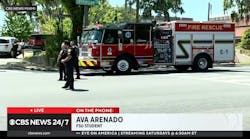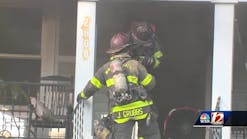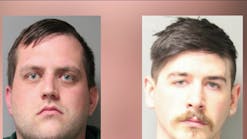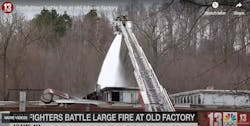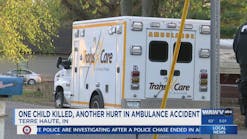From the April 2002 Firehouse MagazineDeputy Chief Peter Hayden Division 1 - 33 years
Firehouse: Were you in quarters when you heard the incident come in?
Hayden: I was in quarters, yes.
Firehouse: Were you just getting off or just coming in?
Hayden: I was continuing on. I worked the night before. I was in my office when I heard a plane coming in low.
Firehouse: You heard the plane come over?
Hayden: Yeah, I looked out the window. I really couldn’t see anything because the building lines obstructed the view, but I heard the crash and I knew right away what it was. I heard the radio right away. I heard Joe Pfeifer, who was already out on the box before I even got out of the office, transmit the third alarm for a plane hitting the Trade Center and he set up a staging area at West and Vesey. I yelled to my aide, come on, let’s go and we started out down toward lower Manhattan.
Firehouse: Was that Chris Waugh? Is he your aide?
Hayden: Chris, yes.
Firehouse: How many years are you in Division 1?
Hayden: Continually since 1997, I was back in Division 1, but I had been in Division 1 prior, from 1993 to ’95. From ’95 to ’97, I was the chief of safety for the fire department. From ’90 to ’93 ,I was a battalion chief in the 2nd Battalion. So since 1990, I’ve been working down in First Division.
Firehouse: Were you working for the explosion in 1993?
Hayden: At the Trade Center, yeah. I wasn’t on duty specifically, but I came in. I was with the 2nd Battalion then.
Firehouse: Were you there for any other major fires or emergencies?
Hayden: Oh, yeah. The most recent one was pretty memorable. We had people trapped in an elevator, with a partial failure of the elevator. We got several people out of the elevator. I think it was on the 78th floor. Pretty hairy rescue operation by the rescue company. It really was.
Firehouse: As you were responding on Sept. 11, what could you see?
Hayden: We went down Broadway, then down Canal and onto West. I saw a large column of smoke surrounding the entire top portion of the building. I didn’t see any flame. I didn’t see any holes or anything. All I saw was the top portion of it covered in smoke. I asked to verify the assignment with the dispatcher. He alerted me that a third alarm was in. I think he was saying that some rescue was not available, and did I need a third one? I said send them.
Firehouse: As you responded in, where did you park?
Hayden: We parked out on West Street by Vesey. We walked in.
Firehouse: Was debris coming down? Was anybody jumping?
Hayden: There was debris coming down. There were a number of people out in the street who were burned. The front windows of the lobby were all blown out, broken. It was chaos. When we were moving to the lobby, there was a lot of damage in the lobby, some people screaming.
Firehouse: Do you remember the extent of the damage?
Hayden: All the marble tiles were off the wall and smashed on the floor.
Firehouse: The people who were burned, were they badly burned?
Hayden: They were conscious and walking, but they were pretty badly burned. There were at least half a dozen of them.
Firehouse: When you went inside, did you go right through the glass or did you go in through the concourse?
Hayden: I went through a door. I don’t know why, but I came in through the door. I went to the left. When I went in, the lobby was to the left. I met up with Joe Pfeifer. He started to brief me on what he had. We already knew that the other plane had struck. And we went through the problem that we were having. They were trying to find an elevator that was working. We were trying to delineate what was going to be the attack stairs, what stage of evacuation have we gotten to, any reports of evacuation and what assignments were made. Port Authority officials were on the scene. We told them to begin evacuating not only the north tower, but the whole World Trade Center complex, start moving everybody out and away.
Firehouse: Did Chief Pfeifer say anything else? Did you receive any other reports at that time?
Hayden: We were getting a number of reports of people burned in the upper floors. I don’t know how exactly he had gotten those reports. He told me of reports of people burned on the upper floors. We didn’t have any specific floors at that time. We had given out assignments to proceed no higher than the 70th floor. The plane supposedly hit the 80th floor. He said, don’t go any higher than 70. That’s where we were going to set up our operations post. There was a lot of discussion on what was operating in the building after the initial assignments. We found out there weren’t any elevators working. Not too long afterwards, we found out we had no communications from the building either. The repeater system wasn’t working. We tried to get that going. We were really at a complete disadvantage. We had no elevator. We had no communication systems. We were getting a number of distress calls, both from our dispatcher and from cell phones, that were coming into the lobby command post near the Port Authority. As we got the distress calls, we were giving out assignments. We were giving specific assignments, if it was a specific report of a floor, of somebody trapped, or if we didn’t have that, we had companies coming in and we were designating a group of floors for them to search. For instance, a battalion chief and three companies, you do floors 21 to 25, make sure everybody’s down. We had Port Authority engineers. We’re working all the time with the Port Authority trying to get, number one, some communications going and also to see if we can get the elevators up and running. One of the engineers was actually going through the elevator intercom system contacting each of the elevators – there were 99 elevators in each of these buildings – and going through each elevator and through the intercom system attempting to contact each car, to see if anybody was in the car. And if they could tell us what floor they were on, we would send somebody up there to get them out of the cars. There were a number of cars where people were reported trapped. The highest one I remember was the 71st floor. I sent a company to the 71st floor. We had reports of people in wheelchairs unable to get off the floors they were on because the elevators weren’t working, so we gave specific assignments for those type of distress calls. We had one report, I think it was around the 40th floor, that as many as 30 people on one floor were severely burned and in need of assistance. So we were at a complete disadvantage. A number of the ranking officers of the department arrived on the scene in a very short period of time from downtown Brooklyn into lower Manhattan. There was a discussion early on about the necessity to establish a command post remote from the lobby command post. We felt it was not a very good area to be operating in the lobby, and we agreed to establish a command post at West and Vesey. And eventually, that’s where the command post was established by the chief of the department and Commissioner Feehan. So the deputy fire commissioner, chief of department and the staff officers left the building to establish the command post across the street over at West and Vesey. Chief Callan, who was the citywide tour commander, remained in the lobby with Joe Pfeifer and me. We manned the lobby command post and directed the operations from there.
Firehouse: Would you or Chief Pfeifer give a specific assignment when the firefighters were coming up?
Hayden: I gave them, or sometimes I gave it to Joe. Sometimes I’d say, Joe, get a company and send them up there. Some of them I gave out specifically. I don’t think there was any set order in how it was done. We used the B stair as the main approach to be our attack stair. That’s what we were using to gain access.
Firehouse: Somebody said that that stairwell went right up from the lowest lobby. Is that correct?
Hayden: Right.
Firehouse: Did you get reports from anybody? Were you getting them or was somebody else getting them? Chief Pfeifer said that they had trouble getting some of the reports, but did you hear anything from the upper floors, any reports of guys going up?
Hayden: We had switched to a command channel, so I was operating mostly on the command channel, but I know there were reports particularly from companies who were operating on the lower floors. Obviously, as they got higher, communications were becoming more and more difficult. I think that the highest level we had any reports from was somewhere in the low 50s. That’s my recollection. I really don’t recall any type of a priority call being relayed down or anything beyond that.
Firehouse: Did you ever hear any Maydays or anything else, or did somebody else hear any Maydays or anything else and then relay the information to you?
Hayden: We heard Maydays after the collapse of the south tower. We heard Maydays then. After the second plane hit the south tower, we had a brief conference.
Firehouse: Did you hear that noise?
Hayden: We felt it. We didn’t know what it was right away, but then somebody told us that a plane hit the second tower. At that point, in time we had a brief conference and we started calling everybody down in the north tower after the second plane hit. We had a number of conferences with the staff chiefs about the possibility of collapse. We recognized the possibility of a collapse, but our thought process was that there was going to be a partial collapse, a gradual collapse after a couple of hours of burning, and we thought we had time to complete the evacuation and get everybody out. We made a conscious decision early on that we weren’t going to try and put the fire out, for a number of reasons. One, there was too much volume of fire. Second, the building systems were probably not functional. We had too many distress calls coming in. We didn’t think the standpipe system was even going to be intact up there. We had to forgo the whole idea of trying to put any fire suppression efforts in there. This was strictly a search and rescue operation. When the second plane hit the south tower, Chief Burns left the lobby of the north tower and went over to assume command of the operations in the south tower. Only a few short minutes after that occurred, we felt it was wise for us to start evacuating this building and we started calling our people down, which was probably about 25 minutes before the north tower collapsed.
Firehouse: Were you aware of companies also in the hotel?
Hayden: We heard on the radio that they had some type of a staging area going there, but I wasn’t directly involved in that. That was coming from the command post out in the street.
Firehouse: Did they ask you if you needed anything else or did you ask them for anything?
Hayden: No, actually, we didn’t want any more people in there.
Firehouse: The south tower came down. Do you hear the noise?
Hayden: We didn’t know specifically what it was. It was certainly a large event, let’s put it that way. We knew something had happened. We didn’t know whether it was an explosion. We don’t know if there was a partial collapse outside. We don’t know exactly what it was. I don’t think anybody knew what happened, but certainly, if you were in the lobby of the north tower, you were covered in debris. We were covered in blackness. There were a couple of people killed. Father Judge was in the lobby. He was killed. We knew that some very calamitous event had just occurred. At that point in time, there were Maydays being given and orders to evacuate the north tower, everybody out, but we had been doing that for 25 minutes. We had been telling guys to come down to the lobby. We realized nobody on the upper floors could hear us, but we were waiting for them to come down. But there still were civilians coming out of the building too at that time. During that whole process, there was a steady flow of people coming down. We started ordering guys down, but at one point later on, I was talking to Chief Downey about collapse. I remember the conversation well. I was saying, they’re not coming down. We’re calling guys down, but they’re not hearing us. Everybody was very concerned. We wanted to just get everybody down. Then there was a steadier flow of people coming down. We answered as many distress calls as we could. But there was a point in time we said all right, come on, come on down, come on down. I was saying that you have to go over the escalators, walk across the cross overpasses because we didn’t want anybody going into the street. There were a lot of bodies hitting the street. We had about 25 elevators. It was a mess. That was the only way to describe it. We knew we were in very deep trouble. They wanted to limit the number of people going in, but we lost control with that because of the off-duty guys coming in and going up the stairs. We could see that. Our main focus was to answer the distress calls, to keep getting people coming down the stairs. But we started calling guys down – come on down, that’s enough, especially after the second plane hit because then somebody had given us an unfounded report that there was a third plane coming in.
Firehouse: Chief Callan sent everybody down at that time. Were you concerned about that?
Hayden: Sure. We were under attack. We knew we were in trouble, so we started calling people down. We had a report from OEM that there was possibility of a third plane coming in. That really put the antennas up for us because, number one, if a third plane does come in and hits these buildings, they’re coming down for sure. Before we had the partial collapse, we were aware that timewise we thought we had a couple of hours. And I think everybody envisioned the idea we’re going to get everybody down and back everybody out a few blocks and watch this event, the top 15 or 20 floors fold in. That’s what we though. It didn’t happen that way, though.
Firehouse: Now, the south tower has come down. You’re in darkness, covered in dust and debris. Where did you wind up and then where did you come out?
Hayden: I wound up in the same place where Joe was. I went back out to see if everything stopped. I went back.
Firehouse: How long do you think it took for it to clear up there, where you had been?
Hayden: Before you could see anything, 15 minutes. You were in darkness in lower Manhattan. It was unbelievable. I went back out to see what the lobby was like and see if we could get out the front door, and I couldn’t see anything. There was a lot of debris in the lobby. Then there was a fireman there, and a victim. And when we got a closer look at him we realized it was Father Judge. Some of the guys picked up Father Judge and carried him up the escalator and out onto the mezzanine level, then out into the walkway. We walked around the outer area of building 6 on the mezzanine level. We went down the escalator walkway down on Vesey Street. We carried Father Judge down there, then we turned him over to some firefighters and EMS. Then I walked back with Chief Callan. We walked back down Vesey, and I met Chief Cassano and a number of other chiefs at West and Vesey who had all assembled there thinking that’s where the command post was. But we didn’t find the command post and somebody said it was down further on the other side of the overpass.
Firehouse: How much debris was down there at that time?
Hayden: Quite a bit, quite a bit. We started walking south toward the overpass with Chief Cassano and we were a little bit north of the overpass when the north tower came down.
Firehouse: What did you hear then?
Hayden: It sounded like a jet roar. You couldn’t run far enough or fast enough. There was a fire truck there. I got down on my hands and knees and I crawled underneath the fire truck. I knew that we couldn’t run.
Firehouse: Were you hit by debris underneath there?
Hayden: I didn’t get hit with anything. The rig got hit with quite a bit of debris, but it didn’t collapse. You saw the stuff raining down onto the sidewalk. The rig was somewhat damaged. And then it stopped, and it was once again deadly quiet. You couldn’t see your hand in front of your face again. I crawled out and I could hear voices again trying to regroup and everything. But it was a while before I could see anything down there.
Firehouse: How long did it take for that dust cloud to clear there until you got a picture of the damage and debris?
Hayden: To really get a good look, it was a good 10 minutes, I think, before I could really see anything clear what was going on. It was unbelievable, the devastation. West Street didn’t exist anymore. It was just covered with debris. The overpass that we were just standing by was completely collapsed and destroyed. Everything was completely down.
Firehouse: Were you getting reports of people missing?
Hayden: We went back to the tactical channel and there was a lot of radio traffic, all kinds of calls for help and Maydays, but nothing specific, not general locations. I went over to West and Liberty and I started working from that sector. Chief Cassano stayed up by West and Vesey. I came down around West and Vesey and I met up with Charlie Blaich, who was already working over there. Charlie and I worked with Chief Mosier, who also showed up.
Firehouse: From that point, if you took a panoramic sweep, what could you see? There’s debris. There’s dust. How about the building at 90 West? Could you see that? Did it have a fire in there right away?
Hayden: We had a good fire in there. We had the equivalent of a fourth-alarm fire in there. We had fire in 50 and 7 World Trade Center. We had fire in 90 West. We had a smaller fire in one of the apartments in Battery Park City that we dispatched companies up there to put out. We had a water supply problem because I remember the water main was broken. Actually, to get water over in our sector over there at West and Liberty we got one of the fireboats to draft for us. It turned out it was the retired John J. Harvey that started drafting for us. That’s what got us water. When somebody total me the Harvey was pumping water, I said the Harvey? Thank God it was there because it pumped for us for about three to five days. Chief Mosier took the operations in 90 West. I gave him X amount of companies. I said just hold it, keep her from jumping the street. The Marriott Hotel was across the street. I said just don’t let it get out of the building here, just try to confine it, and he did a great job up there. They got some lines. They were able to hold it and contain it.
Firehouse: The building just south of that was the Marriott.
Hayden: Across the street. That’s what I was concerned about, that the fire would jump the streets. We had exposure problems, so Bobby’s function was just to contain the fire there. They had a big air shaft in there and he was able to get a line across the shaft and keep it in one wing of the building on the upper floors. And eventually it burned itself out. There was a good fire condition. It was pouring smoke and fire out of there. We were going to a fourth-alarm fire there. If you had to really address this fire, you would be trying to handle it as a fourth alarmer and he had nowhere near that, so he did a good job with that. We also were doing searches along all the debris in front of the Marriott and out on West Street, the void searches.
Firehouse: Other people tell me that there were a lot of firefighters in the street who were visible, and they put out traffic cones to mark them off?
Hayden: Yeah. There was enough there and we were marking off. There were a lot of damaged apparatus there that were covered. We tried to get searches in those areas. By now, this is going on into the afternoon, and we were concerned about additional collapse, not only of the Marriott, because there was a good portion of the Marriott still standing, but also we were pretty sure that 7 World Trade Center would collapse. Early on, we saw a bulge in the southwest corner between floors 10 and 13, and we had put a transit on that and we were pretty sure she was going to collapse. You actually could see there was a visible bulge, it ran up about three floors. It came down about 5 o’clock in the afternoon, but by about 2 o’clock in the afternoon we realized this thing was going to collapse.
Firehouse: Was there heavy fire in there right away?
Hayden: No, not right away, and that’s probably why it stood for so long because it took a while for that fire to develop. It was a heavy body of fire in there and then we didn’t make any attempt to fight it. That was just one of those wars we were just going to lose. We were concerned about the collapse of a 47-story building there. We were worried about additional collapse there of what was remaining standing of the towers and the Marriott, so we started pulling the people back after a couple of hours of surface removal and searches along the surface of the debris. We started to pull guys back because we were concerned for their safety.
Firehouse: Jay Jonas told me that at one point, when he had finally made his way out of the debris, you were standing on top of a truck?
Hayden: Yes. It was covered in debris. I got on top of the rig only to establish a presence there. There was a lot of confusion, a lot of chaos. That was my command post in that sector. I stood on top of the rig and people could see who I was, that there was a chief in charge and that people could come to me and I’d give them assignments. It worked. I didn’t realize it at the time, but it worked. People could point, there’s the chief over there, rather than out of all this chaos and destruction, where was there a command post? You couldn’t even make out West Street. So I saw the rig. I got on top of the rig and I stayed there. And eventually we got a bullhorn, a radio. I had a bullhorn and we were able to get some type of order in the assignments and what we were doing. We tried to get some type of accountability. I gathered everybody around me. There were hundreds of guys and there was a lot of confusion. I had everybody take their helmets off for a moment of silence, and it calmed everybody down. Then, I said, please assist the chief officers in getting some accountability here. Whether you’re on duty or off duty, give them your name, your unit, and give it in to the chiefs. The chiefs made up a list and I had started getting a list of who I had working on the site there, also. It was just an attempt to gain some kind of control.
Firehouse: So you were able to move forward a little bit at that point?
Hayden: At that point. And then also when I got everybody around. I didn’t know how many chiefs I had there. I just told them what we’re going to do, we’re going to split this up into companies. I did it by getting them to stop and take their helmets off for a moment of silence.Once I had the moment of silence, then I started giving out the orders to everybody about what we’re going to do. After that, we had some type of organization. That’s the only way I could have done it. I couldn’t think – I needed help. It was a desperate measure.
Firehouse: Chief Nigro said they made a collapse zone and wanted everybody away from number 7— did you have to get all of those people out?
Hayden: Yeah, we had to pull everybody back. It was very difficult. We had to be very forceful in getting the guys out. They didn’t want to come out. There were guys going into areas that I wasn’t even really comfortable with, because of the possibility of secondary collapses. We didn’t know how stable any of this area was. We pulled everybody back probably by 3 or 3:30 in the afternoon. We said, this building is going to come down, get back. It came down about 5 o’clock or so, but we had everybody backed away by then. At that point in time, it seemed like a somewhat smaller event, but under any normal circumstances, that’s a major event, a 47-story building collapsing. It seemed like a firecracker after the other ones came down, but I mean that’s a big building, and when it came down, it was quite an event. But having gone through the other two, it didn’t seem so bad. But that’s what we were concerned about. We had said to the guys, we lost as many as 300 guys. We didn’t want to lose any more people that day. And when those numbers start to set in among everybody… My feeling early on was we weren’t going to find any survivors. You either made it out or you didn’t make it out. It was a cataclysmic event. The idea of somebody living in that thing to me would have been only short of a miracle. This thing became geographically sectored because of the collapse. I was at West and Liberty. I couldn’t go further north on West Street. And I couldn’t go further east on Liberty because of the collapse of the south tower, so physically we were boxed in. But you could see the fires burning in 4, 5 and 6. They became fully involved. We had fire on the 15th floor of one of the high-rises. I gave a battalion chief two companies. I said go up there, put this fire out. I told him, don’t call for any help, don’t give any signals, just put the fire out and come back and tell me when the fire’s out. This is all you’re getting, put it out. Fortunately, you know, it wasn’t large, it was out one window. At some time that night, it was dark and I had had it. I went down and I got my eyes washed out. They took me to the eye station and then they took me to Bellevue. I had my eyes washed out and then I met up with my brother, who’s also a firefighter.
Firehouse: As you’ve said, it was a cataclysmic event. Were you surprised by the extent of the destruction?
Hayden: Oh, yeah. I just couldn’t believe it. Two 110-story buildings gone, and I’m in lower Manhattan and I can’t make out streets or anything. Then, when I was assigned to start cleaning up, I thought, where do we begin? Where do we even begin? We couldn’t even find the streets. They’re in there somewhere.

